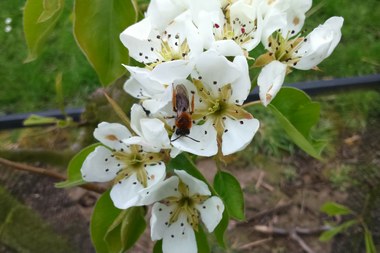In search of the added value of wild bees for fruit
(27-03-2017) Researchers from Ghent University led by Prof. Guy Smagghe studied the contribution of wild bees to fruit pollination.
The pollination service of wild bees and other pollinating insects in fruit cultivation is still too often underestimated. Everyone agrees that wild bees and other insects can offer added value, but how do you determine that added value? For this reason, a team of researchers led by Professor Guy Smagghe of the Faculty of Bioscience Engineering at Ghent University, in collaboration with the Research Centre for Fruit Cultivation, is studying the contribution of wild bees. As part of the biodiversity section of the Bayer ForwardFarming Chair, they also took a closer look at the pear orchard at the Forward Farm in Huldenberg.
With approximately 16,000 hectares of orchards in the open air, fruit cultivation is an important economic activity in Flanders. The fruit plantations are mainly located in Haspengouw in Limburg and Hageland in Flemish Brabant. Both regions together represent a production value of approximately 300 million euros, or about 76 percent of the total Flemish fruit production.
For a good yield, fruit growers are highly dependent on the weather, diseases and pests, but they must also hope for efficient and intensive pollination of the crops in question. Especially with pear, apple and sweet cherry, pollination by insects is necessary to produce good fruits. To ensure proper pollination, fruit growers hire beekeepers who place beehives in the plantation, or make use of domesticated bees, such as buff-tailed bumblebee. This comes at a price.
Even more efficient however, is to cooperate with nature, because several types of fruits are also pollinated by wild bees and other naturally occurring insects. In this way, they help to stabilize and improve fruit growth and improve the fruit quality with a better yield as a result. These pollination services are free and are still too often underestimated. The extent to which this natural pollination service contributes to the final yield is not so easy to determine. In apple, pear and cherry cultivation, various research projects are underway to find out.
The research team of Professor Guy Smagghe of the Faculty of Bioscience Engineering at Ghent University, together with the Research Centre for Fruit Cultivation (pcfruit), is trying to find an answer to a number of pressing questions. "One of the questions we still have to find an answer to is which specific wild bees and other insects play a role in the pollination of the various fruits in Flanders," says Professor Guy Smagghe. "Through monitoring in orchards, we try to find out which pollinating insects (mason bees, sand bees, bumblebees or hoverflies) visit the fruit blossoms. After all, of some 350 species of wild bees in Flanders, not every species can make an equally important contribution to the pollination of certain fruit plantations."
"In the second instance, we will also check whether the pollinators find their way to nesting assistance, such as hollowed-out nesting corridors for mason bees and sand heaps for sand bees," continues researcher Stijn Raymaekers of pcfruit. "For the sand bees, we have built a few sand heaps in the pear orchard at the Bayer Forward Farm in Huldenberg, where we also try to check how maintenance-friendly this is in practice for farmers."
Raymaekers: "In the case of mason bees, we investigate which nesting materials are preferred and how their chances of survival change as these materials age. On the farm in Huldenberg, where nest blocks and the introduction of mason bee cocoons to promote pollination have been used for four years, we also examined the pollen that the mason bees apply for their larvae for the presence of pear pollen. This allows us to distinguish to what extent the mason bees fly to pear blossoms and which other plants are also important for these bees."
In addition to extra nesting assistance, the landscape itself also plays an important role. "After all, one landscape can be a lot more 'bee-friendly' than the other and therefore have an influence on the yield," says Professor Smagghe. "That's why we're also investigating what types of landscape elements, such as wood edges and forest edges, whether plant species, such as willow and dandelion, are beneficial to support diverse communities of wild pollinating insects before and after the fruit's flowering."
Stijn Raymaekers underlines this importance and finds it encouraging that several growers have already shown themselves willing to plant mixed hedges for the benefit of pollinators. "Also at the Bayer Forward Farm, a mixed hedge was planted five years ago with the intention of providing a shelter for beneficial insects and at the same time attracting wild bees. Before and after the pear flowering in the immediate vicinity, we looked at which plants support pollinating insects and which do not. It is clear that the different groups of pollinating insects, such as bumblebees, solitary bees or hoverflies, need different plant species to thrive."
Professor Smagghe: "Finally, we also try to map the fruit setting and fruit quality in the same orchards. In the long term, we can then make the link between certain species of bees or other insects and a better yield in certain plots, so that we can identify certain useful pollinators for the different crops and recommend control measures." Exploratory research by pcfruit already gives good hope: among all pear growers who participated in 2016, a significantly higher fruit weight of conference was measured in plots where nest blocks for mason bees were hung.
This research is being carried out in the context of two FWO projects at Ghent University, an Interreg project ‘Meer Natuur voor Pittig Fruit’, in which pcfruit participates and the biodiversity part of the 'Bayer ForwardFarming' chair with the aim of linking scientific insights to practice.

